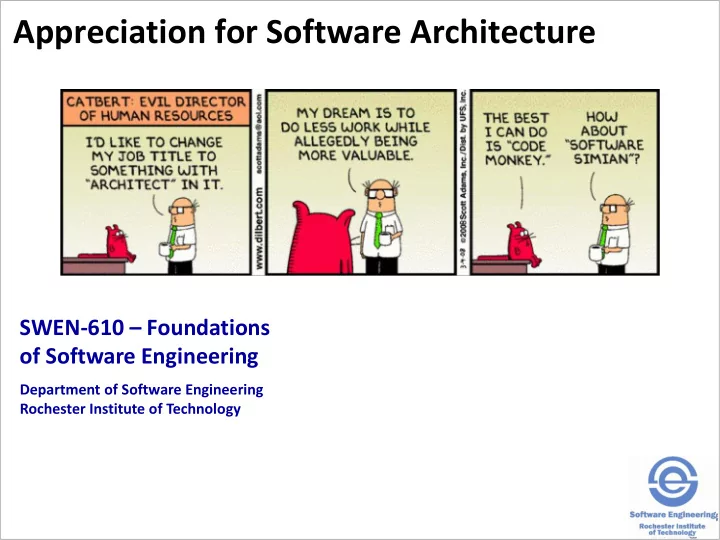

Appreciation for Software Architecture SWEN-610 – Foundations of Software Engineering Department of Software Engineering Rochester Institute of Technology
Why is architecture important? Martin Fowler in Patterns of Enterprise Application Architecture: “The highest -level breakdown of a system into its parts; the decisions that are hard to change; there are multiple architectures in a system; what is architecturally significant can change over a system's lifetime; and, in the end, architecture boils down to whatever the important stuff is.” Solution communication and consensus among stakeholders Earliest and most fundamental design analysis and decisions Directs and constrains remaining software development, deployment, and maintenance Dictates structure of development organization Enables early evolutionary prototyping Enables more accurate cost and schedule estimation 2
Architecture is the highest-level design of a system 3 The Software Architect , by Matthew McBride (COMMUNICATIONS OF THE ACM May 2007/Vol. 50, No. 5)
Requirements affect the system architecture Non-functional requirements (NFRs) and constraints lead to a logical and physical architecture. Operational NFRs: • Scalability • Availability … Developmental NFRs: • Testability • Portability … Constraints: • Pre-chosen system components (eg, database) • Pre-chosen frameworks … 4
Architecture is guided by principles and patterns Manage risk Build vs buy vs open source Separation of concerns Architectural patterns are selected to satisfy NFRs • Failover and Load Balancing • Model-View-Controller • Tiers and Layers For example: UI, Application and Model • Java EE Patterns No one architecture is right or wrong, just more or less useful for a given application. (attribution unknown) • Does it satisfy the NFRs? • Ad-hoc architecture is not very useful. 5
Visualize the architecture in the Inception phase WebCheckers Inc hired a contract architect who produced the Vision document: First, the application must be on the web. The architect has also identified several frameworks to use. 6
Build out the architecture in the Elaboration phase The architecturally-significant user stories are prioritized during the Elaboration. The Dev Team is frequently guided or lead by an architect during this phase. The working increment at the end of Elaboration forms the starting point of the system architecture. • There will be architectural additions over the lifetime of the system. • Avoid changing established architectural norms. 7
Architecture is modeled using tiers UI Model Application The User interacts with the User Interface (UI) tier. The UI tier interacts with the Application and Model tiers. The Application tier holds logic that controls the flow of the application. The Model tier holds the core domain (aka "business") logic. 8
Architecture must also consider layers UI Model Application System Frameworks Platform OS/Hardware 9
Let's start with a simple, desktop architecture UI Model Application Java Frameworks Swing Java Platform Any OS and HW OS/Hardware 10
This is the architecture you will use in the web ‐ based term project. Client UI Server UI Model Application Network Connection HTML, CSS Spark & Spark & JavaScript (for Session) FreeMarker Frameworks Any Java Browser Platform Web server (Jetty) Any OS and HW Any OS/Hardware OS/HW 11
Recommend
More recommend